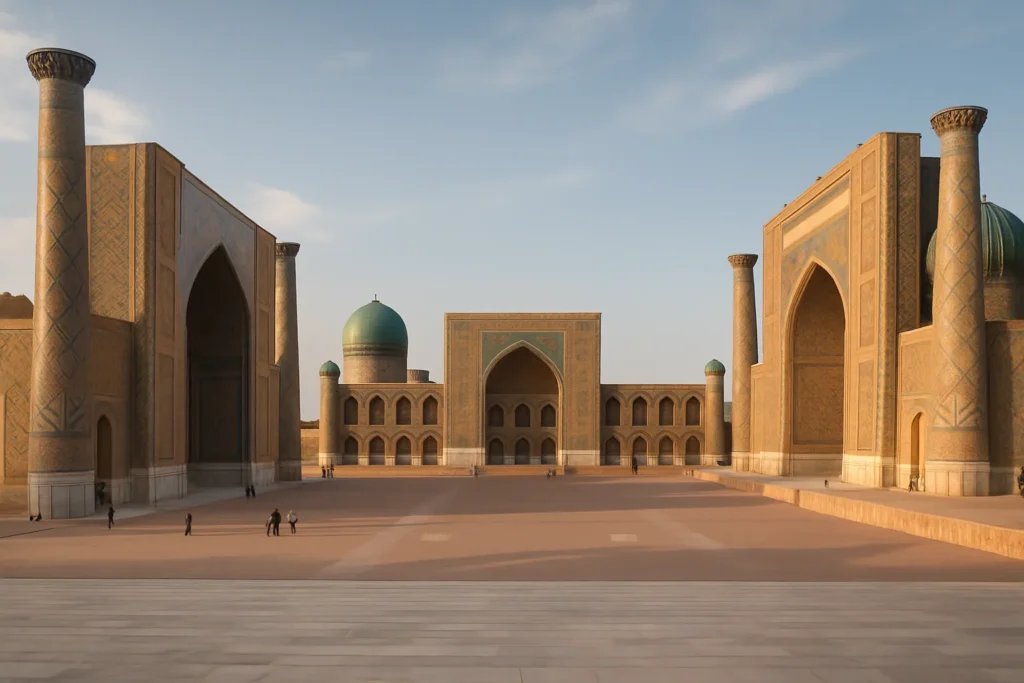If there is one place in Uzbekistan that captures the soul of Central Asia, it is the Registan Ensemble in Samarkand. Standing in this grand square, surrounded by towering madrasahs decorated with intricate blue and gold mosaics, you feel as though history is speaking directly to you. For centuries, Registan has been the beating heart of Samarkand, a city once known as the crossroads of the Silk Road, where traders, scholars, and travelers from across the world came together.
The ensemble is more than just a collection of beautiful buildings—it represents the height of Islamic architecture during the Timurid dynasty and remains a living reminder of the region’s artistic brilliance. Its detailed tilework, monumental arches, and golden domes make it one of the most breathtaking landmarks in all of Central Asia. Recognized today as a UNESCO World Heritage Site, the Registan Ensemble continues to attract visitors not only for its beauty but also for its cultural importance, symbolizing the blend of science, art, and faith that flourished here centuries ago.
The Origins and Historical Timeline
The word Registan comes from Persian, meaning “sandy place” or “desert square.” Long before the iconic madrasahs were built, this open ground was the central gathering space of Samarkand. It was here that people heard royal proclamations, celebrated festivals, and watched public ceremonies. You could imagine it as the beating heart of the city where life, trade, and authority came together.
The first major transformation of this square began in the early 15th century under the vision of Ulugh Beg, the grandson of Timur (Tamerlane). Between 1417 and 1420, Ulugh Beg built the madrasa that now bears his name. Unlike many rulers of his time, Ulugh Beg was more passionate about science and education than conquest. His madrasa was not only a school for Islamic theology but also a center of astronomy, mathematics, and philosophy. Some of the greatest scholars of the age taught and studied here, turning Samarkand into a city of knowledge that rivaled the intellectual hubs of the world.
Two centuries later, the square saw another wave of grandeur. The Sher-Dor Madrasa, built between 1619 and 1636, stood boldly across from Ulugh Beg’s creation. Its patron, Yalangtush Bahadur, wanted to mirror the earlier madrasa but with more elaborate decoration. The most striking detail is the pair of lions chasing deer across its portal—an unusual motif in Islamic art, where animal imagery was rare. These lions, however, symbolized strength, courage, and the rising sun, showing how local culture and Islamic traditions blended here.
Soon after, the ensemble was completed with the construction of the Tilya-Kori Madrasa (1646–1660). Its name means “gilded” or “decorated with gold,” and once you step inside, you understand why. The central prayer hall shines with golden ornamentation, giving a sense of divine richness. Unlike the first two madrasahs, Tilya-Kori was both a madrasa and a mosque, making it the spiritual and cultural hub of the Registan.
Together, these three monumental madrasahs tell a story that spans over two hundred years. They show how Timurid dynasty art and Islamic learning evolved—first with a focus on scholarship and science under Ulugh Beg, then with bold architectural experimentation at Sher-Dor, and finally with the fusion of spirituality and artistry at Tilya-Kori. Standing in the square today, you don’t just see buildings—you see centuries of ambition, culture, and devotion carved into every tile and arch.
Architectural Brilliance and Decorative Art
The first thing that takes your breath away when you step into the Registan Ensemble is the sheer balance of its layout. The three madrasahs stand like guardians around the square, each with its own courtyard, arched iwans, and towering minarets. Their massive domes, rising elegantly against the sky, make the ensemble feel both grand and harmonious, as if every detail was placed with mathematical precision.
What truly brings these structures to life, however, is the decoration. The walls and arches are dressed in a dazzling skin of tilework and mosaics, created with techniques such as majolica (glazed ceramics painted in vivid colors) and carefully set glazed bricks. Shades of deep blue, turquoise, white, and gold shine across the facades, shifting in tone as the sun moves across the sky. Each tile is more than just decoration—it is a small piece of art crafted by hand, carrying the skill of artisans who worked centuries ago.
If you look closely, you’ll notice the symbolism in the motifs. At Sher-Dor, the bold lions and suns symbolize power, energy, and protection. Across the madrasahs, intricate geometric patterns reflect the Islamic philosophy that harmony and infinity exist in numbers and shapes. Floral designs echo the beauty of paradise gardens, while Arabic calligraphy winds gracefully across the surfaces, often inscribing verses from the Qur’an or wise sayings. These patterns are not just beautiful; they carry messages of faith, strength, and learning.
Another wonder lies in the construction methods. Despite earthquakes and centuries of weather, much of the ensemble still stands tall. The builders used clever engineering, including slightly tilting minarets and flexible brickwork, to absorb shocks and prevent total collapse. These choices show not only architectural brilliance but also practical mastery in adapting design to the realities of Central Asia’s seismic landscape.
The influence of Registan’s architecture spread far beyond Samarkand. Its style of monumental portals, rich tile mosaics, and symbolic decoration inspired countless structures across Central Asia, Iran, and even Mughal India. Standing in front of the ensemble, you realize it was not just a local masterpiece but a blueprint that shaped the visual language of Islamic architecture across the region.
Restoration and UNESCO World Heritage Significance
For all its grandeur, the Registan Ensemble has not always stood in perfect condition. Over the centuries, the square endured its share of hardships—earthquakes shook its minarets, invasions left it neglected, and changing political powers sometimes treated it with less care than it deserved. By the 19th century, travelers described parts of Registan as crumbling, with domes collapsing and mosaics fading under layers of dust and time.
The true turning point came in the 20th century, when Soviet authorities recognized the ensemble’s cultural value and began large-scale restoration efforts. Between the 1920s and 1980s, teams of architects and artisans worked painstakingly to rebuild what nature and neglect had damaged. Minarets that once leaned dangerously were straightened, collapsed domes were reconstructed, and missing tiles were replaced with newly crafted ones designed to match the originals. These restorations were not without debate—some critics argued they went too far—but they ensured that Registan would not be lost to history.
In recent decades, international funding and expertise have continued the work. Conservation specialists from across the world have joined Uzbek experts to strengthen foundations, protect fragile mosaics, and ensure that modern techniques respect traditional craftsmanship. The guiding principle has been simple: restore what is necessary, but preserve the authenticity of the site.
Recognition of this importance came when Registan, as part of Samarkand’s historic center, was inscribed as a UNESCO World Heritage Site in 2001. UNESCO highlighted its significance as a cultural crossroads, a masterpiece of Islamic architecture, and a living symbol of Central Asian heritage. The designation brought global attention, more conservation support, and a stronger commitment to safeguarding the ensemble for future generations.
Even today, challenges remain. Climate change, with its increasing temperature extremes and heavy rains, threatens the delicate tiles. Growing numbers of tourists, while a blessing for local culture, put pressure on the site’s courtyards and interiors. Managing access, controlling visitor flow, and funding ongoing repairs are constant concerns. Yet despite these hurdles, Registan continues to shine—its survival a testament to the dedication of those who see it not just as a monument, but as a legacy that must endure.
Cultural and Symbolic Role
To truly understand the Registan Ensemble, you have to see it as more than just stone, tiles, and domes. For centuries, it was the intellectual and spiritual heart of Samarkand. In the time of the Timurid empire, the madrasahs were more than religious schools. They were centers of learning, science, and philosophy, where scholars studied astronomy, mathematics, and literature alongside theology. Ulugh Beg himself, one of the greatest astronomers of the 15th century, often walked these courtyards, teaching students and encouraging knowledge that stretched far beyond the region.
Today, Registan is also a symbol of Uzbek identity and national pride. It appears on currency, in art, and in countless photographs that represent Uzbekistan to the world. Ask any local about Registan, and you’ll notice a spark of pride in their voice. For Uzbeks, it is not only a reminder of their history but also a celebration of their resilience and cultural brilliance.
The square’s importance goes far beyond national borders. As part of the Silk Road, Registan was a space where traders, diplomats, and travelers from across Asia, the Middle East, and even Europe once gathered. Ideas, languages, and art forms flowed freely here, making it a true crossroads of global cultural exchange. You can almost feel that energy still lingering when you stand in the middle of the square and imagine merchants from Persia, India, and China meeting under the gaze of its glittering facades.
Even in modern times, the square continues to breathe with life. Festivals and cultural events bring music and dance back to its courtyards, just as they did centuries ago. The most famous is the Sharq Taronalari (Melodies of the East) festival, which gathers artists from around the world every two years. And when evening falls, the ensemble glows under brilliant light shows, turning the square into a stage of gold and sapphire. Standing there at night, surrounded by illuminated domes and arches, you feel like history has come alive in the present moment.
Visiting the Registan Ensemble: A Practical Guide
If you’re planning to see the Registan Ensemble, timing is everything. The square changes its mood with the light. At sunrise, the courtyards are peaceful, bathed in a soft golden glow, perfect if you want to enjoy the space quietly. By sunset, the tiles shimmer in shades of blue and orange, making it a photographer’s dream. And after dark, the nighttime light displays transform the ensemble into something magical, with each madrasa glowing like a jewel against the Samarkand sky.
Tickets and access are straightforward. Entry usually requires a small fee, and you can buy tickets on-site. The ensemble is open throughout the day, though hours may vary slightly by season, so it’s always best to check locally. Most of the main courtyards are accessible, and sometimes you can even explore upper floors for a small additional fee.
When it comes to exploring, you can go in two ways. Guided tours give you rich stories, hidden details, and the historical context you might otherwise miss. But if you prefer to take your time, wandering alone lets you move at your own pace and soak in the atmosphere without interruption. Many travelers actually do both—taking a guided tour first and then returning on their own for a more personal experience.
For photography, patience pays off. The grand portals are stunning from the front, but don’t miss the little details—close-ups of tiles, calligraphy bands, or the play of sunlight on the domes. The best times for photos are early morning and late afternoon, when the light is softer and the colors are richer. At night, bring a tripod if you can, as the illuminated mosaics deserve a long, steady capture.
Samarkand itself offers plenty nearby. Just a short walk from Registan you’ll find the Gur-e-Amir Mausoleum, resting place of Timur; the Bibi-Khanym Mosque, once one of the largest in the Islamic world; and the breathtaking necropolis of Shah-i-Zinda, with its turquoise-tiled tombs. Together, these sites create a journey through centuries of Central Asian history.
For staying and eating, Samarkand offers a blend of choices. Boutique hotels near the old city give you a cozy, authentic feel, while larger hotels provide comfort and amenities. When it comes to food, don’t miss traditional Uzbek dishes like plov (rice with lamb and vegetables), samsa (savory pastries), and fresh bread baked in clay ovens. Sharing a meal here after walking through Registan feels like continuing the story of hospitality and culture that has always defined this city.
Expert Perspectives and Personal Insights
Historians often describe the Registan Ensemble as one of the most complete and breathtaking examples of Islamic architecture in the world. Scholars highlight how its design influenced later structures across Central Asia and even inspired elements in Mughal India, such as the balance of courtyards and monumental facades. For many experts, Registan is not only a national treasure but also a global reference point for Timurid architecture.
Architects who study the site emphasize its daring engineering. They point to the slender minarets that were designed to absorb seismic shocks, and to the precise mathematics behind the domes and arches. To them, Registan is proof that medieval builders combined artistry with science in ways that still impress modern engineers.
Conservation specialists add another layer of insight. They explain how difficult it is to preserve the ensemble’s fragile tilework, especially in a region prone to earthquakes and climate extremes. Each mosaic, they say, must be treated like a piece of jewelry—cleaned, repaired, and protected without losing its authenticity. The challenge lies in balancing tourism with preservation: allowing millions of visitors to admire the site while making sure its delicate structures remain unharmed for centuries to come.
On a personal note, nothing prepares you for the first moment you step into the square. The scale is overwhelming—you feel small, yet uplifted, as the madrasahs rise around you like giants dressed in blue and gold. What struck me most was the silence between the crowds. Even with people around, there are moments when the wind brushes past the tiles, and you feel as though history itself is whispering. My favorite memory was watching the sun dip behind the domes at dusk, turning the tiles into a canvas of shifting colors. It’s in those moments that you realize Registan is not just about architecture—it’s about the emotions it stirs and the connection it creates across time.
Conclusion
The Registan Ensemble is far more than a collection of beautiful madrasahs. It is a living symbol of history, science, culture, and resilience. Every tile, every arch, and every courtyard tells the story of a city that once stood at the crossroads of the Silk Road, where knowledge and faith thrived side by side. From Ulugh Beg’s vision of scholarship to the golden splendor of Tilya-Kori, Registan embodies the creativity and determination of generations who built something timeless.
The key lesson it offers us today is the value of preserving heritage. Without careful restoration and global awareness, masterpieces like Registan could easily have been lost. Thanks to conservation efforts, future generations will still be able to stand in this square, look up at its glowing domes, and feel the same sense of wonder that travelers have felt for centuries.
As visitors, our role is simple but powerful: to engage with Registan respectfully, to learn from its stories, and to appreciate its beauty without taking it for granted. By traveling thoughtfully and supporting cultural preservation, we help ensure that this jewel of Samarkand continues to inspire not just as a monument of the past, but as a beacon of human achievement for the future.

Hi, I’m Bilal, the founder of outofmagazine.com. I love sharing fresh ideas, stories, and helpful insights on all kinds of topics that spark curiosity. My goal with this site is simple—to create a space where readers can find inspiration, useful tips, and engaging reads on lifestyle, trends, and everything in between.



